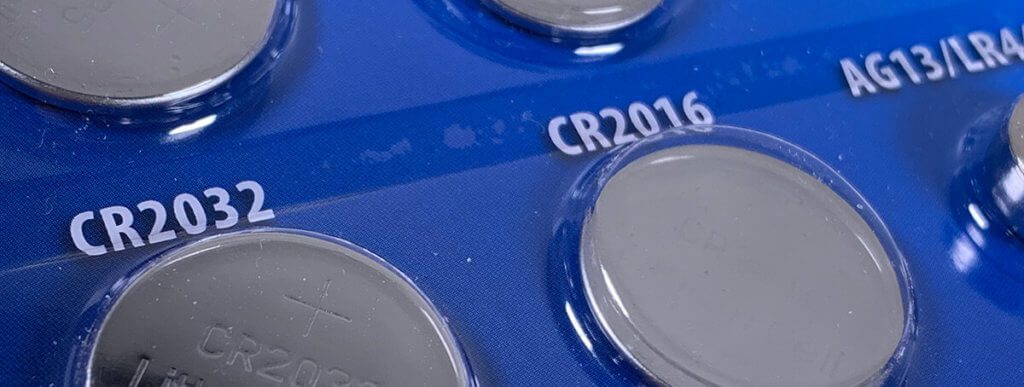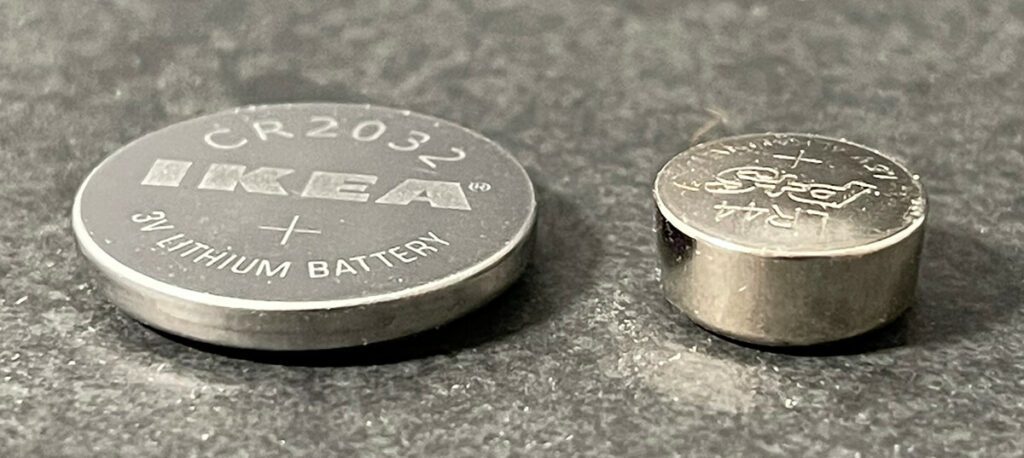They are the energy supply for numerous devices that we use today. Lawn mowers, smartphones, tablets and toys for children are powered by batteries or accumulators. Modern devices are often supposed to support mobility and are accordingly equipped with powerful batteries. In some devices, however, batteries - or more precisely button cells - are better suited than rechargeable batteries, as they can store the energy over a longer period of time. While even modern lithium-ion batteries experience a significant loss of stored energy within a few months, button cells can store electricity for several years without any problems. This is particularly useful if, for example, with smoke detectors, electricity is only rarely used.

Chapter in this post:
- 1 differences in battery technology: Li-Ion, NiMH, NiCd, Lipo
- 2 batteries and button cells - long energy storage
- 3 Overview / table of battery sizes and dimensions
- 4 rechargeable batteries and batteries
- 5 camera batteries
- 6 button cells
- 7 abbreviations in the name
- 8 What types are there?
- 9 BR series
- 10 CR series
- 11 LMR series
- 12 LR series
- 13 MR series
- 14 PR series
- 15 SR series
- 16 ZR series
- 17 button cell comparison list
Differences in battery technology: Li-Ion, NiMH, NiCd, Lipo
With the development of battery technology, new physical combinations have always been found. All of them have various advantages and disadvantages. While lithium polymer batteries (Lipos) have a particularly high energy density and a high short-term discharge current, their storage time and the number of charging cycles are rather low. Storage in a full condition is particularly negative for this type of battery. The battery is already damaged after a week, which severely limits its capacity. For this reason, it is often found in model aircraft and quadrocopters that need a lot of energy for a short time.
The most widespread battery technology is currently likely to be lithium-ion technology. This is used in tablets, laptops, smartphones and wearables. The advantage of these batteries is that they have no memory effect and can also store a lot of energy in a small volume. This is an important property, especially for small mobile devices.
I would like to give you some product recommendations for the various replacement batteries that are used in various devices. For this I have set up corresponding sub-pages for these products, which you can find via the following links. If a word is not yet linked, this subpage does not yet exist.
Batteries and button cells - long energy storage
The advantage of batteries and button cells that cannot be recharged. It is clearly in their property that they can store the energy over a long period of time. For this reason, they can also be found in smoke detectors with a Q certificate, which give a 10-year guarantee that no batteries have to be changed during this time.
Another - less well-known - advantage is the fact that their output voltage remains relatively the same even with decreasing capacitance. This means that while with rechargeable batteries a clear drop in the output voltage is often noticeable towards the end of the charge, the voltage curve with disposable batteries does not go down as much. This is important for many electronic devices as they monitor the voltage and suggest a battery change if the voltage is too low. If you now take a battery, this warning message is ejected much earlier - even if the battery is just about to start discharging.
Overview / table of battery sizes and dimensions
In order to make the search for the right battery easier, I have put together a table that shows you the sizes in different specifications and dimensions. I have compiled the information from the corresponding Wikipedia page. Due to the amount of data, I have planned an extra page for button cells, which will be linked here shortly.
| designation | IEC | ANSI | Size: | tension | Regarding Amazon |
|---|---|---|---|---|---|
| D / mono | R20 | 13 | 34,2 x 61,5 mm (ø x H) | 1,5 V | Amazon |
| C / baby | R14 | 14 | 26,2 x 50 mm (ø x H) | 1,5 V | Amazon |
| Sub C | R22C429 | - | 22,2 x 42,9 mm (ø x H) | 1,2 V (battery) | NiMH battery NiCD battery |
| B | R12 | - | 21,5 x 60 mm (ø x H) | 1,5 V | Amazon |
| A | R23 | - | 17 x 50 mm (ø x H) | 1,2 V (battery) | Amazon |
| AA / Mignon | R6 | 15 | 14,5 x 50,5 mm (ø x H) | 1,5 V | Amazon |
| AAA / Micro | R03 | 24 | 10,5 x 44,5 mm (ø x H) | 1,5 V | Amazon |
| AAAA / mini | R8D425 | 25 | 8,3 x 42,5 mm (ø x H) | 1,5 V | Amazon |
| N/L20/Lady | R1 | 910 | 12 x 30,2 mm (ø x H) | 1,5 V | Amazon |
| Duplex | 2R10 | - | 21,5 x 74 mm (ø x H) | 3,0 V | Amazon |
| 4AG13/L1325 | 4R44 | - | 13 x 25 mm (ø x H) | 6,0 V | Amazon |
| 23A | 8R932 | 1811A | 10,3 x 28,5 mm (ø x H) | 12,0 V | Amazon |
| Flat battery | 3R12 | - | 65 x 61 x 21 mm | 4,5 V | Amazon |
| Lantern battery | 4R25 | 908 / 915 | 114 x 66 x 66 mm | 6,0 V | Amazon |
| 9 volt block | 6F22 | 1604 | 48 x 26 x 17 mm | 9,0 V | Amazon |
| 12F20 battery | 15F20 | - | 50 x 25 x 15 mm | 22,5 V | Amazon |
Rechargeable batteries and batteries
- 18650 battery
- 18650 battery charger
- Sanyo charger
- Samsung Galaxy S3 battery
- Samsung Galaxy S3 mini battery
- Battery Samsung Galaxy S4 / S4 mini
- Power Bank
- Solar power bank
- Anker power bank
- Power bank 20000mAh
- Power bank 50000mAh
- Car battery
- AGM battery
- starter battery
- AA batteries
- AAA batteries
- Disconnect battery (disconnect car battery)
- Bridge battery (car)
- battery tester
- Bios battery
- 12V Battery
- Varta car battery
- Gel battery
- 18650 battery
- Battery charger
- 9V Battery
- CR123A battery
- CR123A battery / RCR123A
- CR17345
- Motherboard battery
- AAAA battery
- battery monitor
- Mignon battery
- Check car battery
- Motorcycle battery
- Truck battery
- Battery A23
- Tesla battery
- 6V Battery
- MagSafe-Power bank
- LiFePo4 battery
Camera batteries

button cell
Button cells are small batteries in the shape of a button - hence the name. The small design of the button cells makes them perfect for use in devices such as remote controls, car keys, kitchen scales, hearing aids (see Hearing aid batteries of type 10 or P10, Type 312 or P312, Type 13 or P13 or type 675 or P675), wristwatches (see also Watch battery), Calculators and the like. Another great advantage of button cells is the fact that they have an extremely low self-discharge and can therefore maintain the voltage for years. NiMH or lithium batteries, on the other hand, would lose a large part of the electrical energy within 6 to 12 months, making them unsuitable for this area of application.
Abbreviations in the name
The first letter in the name of the button cell stands for the cell type. There are these versions:
- M stands for mercury oxide zinc cell
- P stands for zinc-air cell
- L stands for alkaline manganese cell
- Z stands for nickel oxyhydroxide cell
- S stands for silver oxide zinc cell
- C stands for lithium manganese dioxide cell
- B stands for lithium carbon monofluoride cell
If you are surprised that M is also listed for mercury oxide-zinc cells, you should be reassured: Since 10/2015, cells that contain more than 0,0005 percent by weight of mercury have been allowed in not be sold in the European Union.

Which types are there?
The button cells are available in different capacities, cell types and sizes. The common designation is based on the IEC designation, which uses the abbreviation to precisely define which model is in front of you. Since this designation is also common in retail, I would like to list the most common models here.
Some battery names refer to one model each, which is why I summarize them in one bullet point:
- AG1, 364, LR621
- AG3, 392, LR41
- AG4, 377, LR626
- AG10, 389, LR1130
- AG12, 386, LR43
- AG13, 357, LR44
- CR1620
- CR2016
- CR2025
- CR2032
BR series
- BR1225
- BR2032
- BR2325
- BR2330
- BR3032
CR series
- CR1025
- CR1216
- CR1220
- CR1225
- (CR123A)
- CR1616
- CR1620
- CR1632
- CR2012
- CR2016
- CR2025
- CR2032; see also CR2032: the differences to CR2025 and CR2016 batteries
- CR2320
- CR2325
- CR2330
- CR2354
- CR2430
- CR2450
- CR2477
- CR927
LIR series (rechargeable battery button cells)
- LIR2032
- LIR2450
- LIR2477
- LIR2430
- LIR2025
- LIR2016
LMR series
- LMR2016
LR series
- LR1120
- LR1130
- LR1142
- LR1154 (also LR44, 357 or AG13)
- LR16114
- LR1662
- LR2361
- LR521
- LR616
- LR621
- LR626
- LR721
- LR726
- LR736
- LR754
- LR936
MR series
- MR16114
- MR1662
PR series
- PR1154
- PR536
- PR736
- PR754
SR series
- SR1116
- SR1120
- SR1130
- SR1136
- SR1142
- SR1154
- SR416 (also V337F or SR416SW)
- SR512 (also V335MF or SR512SW)
- SR516 (also V317MF or SR516SW)
- SR521
- SR527
- SR614
- SR621
- SR626 (also SR66, 377, V377MF, D377 or SR626SW)
- SR712
- SR716
- SR721
- SR726
- SR731
- SR736
- SR754
- SR916
- SR921 (also SR69, V371MF, 371, D371 or SR920SW)
- SR927
- SR936
ZR series
- ZR626

Button cell comparison list
To find the right button cell for the hearing aid, I have one here Comparison list for hearing aids as PDF created. It lists the well-known color codes and type designations of hearing aid batteries according to ICE and ANSI and corresponding offers from manufacturers such as Duracell, Varta, Rayovac, AmazonBasics, Ansmann, Panasonic, Siemens and Renata are linked directly to the corresponding product on Amazon.
